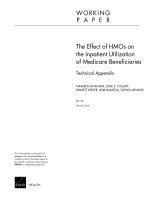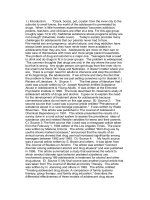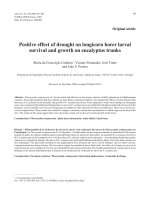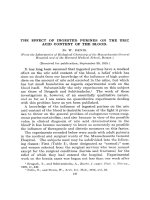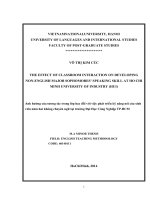Effect of Lactobacillus Sakei as protective culture on extended storage life of chicken breast fillets kept under refrigeration temperature
Bạn đang xem bản rút gọn của tài liệu. Xem và tải ngay bản đầy đủ của tài liệu tại đây (344.45 KB, 9 trang )
Int.J.Curr.Microbiol.App.Sci (2019) 8(2): 2827-2835
International Journal of Current Microbiology and Applied Sciences
ISSN: 2319-7706 Volume 8 Number 02 (2019)
Journal homepage:
Original Research Article
/>
Effect of Lactobacillus sakei as Protective Culture on Extended Storage Life
of Chicken Breast Fillets kept under Refrigeration Temperature
Pompi Rani Boro1*, Pragati Hazarika1, Kuleswan Pame2, Kevimese Khate1 and
Lhingneihoi Hangsing1
1
Department of Livestock Products Technology, College of Veterinary Sciences & Animal
Husbandry, Central Agricultural University, Selesih, Aizawl, Mizoram, India
2
Department of Livestock Products Technology, Lakhimpur College of Veterinary Sciences,
AAU, Joyhing, North Lakhimpur, Assam, India
*Corresponding author
ABSTRACT
Keywords
Lactobacillus sakei,
Microbiological and
Sensory parameters
Article Info
Accepted:
20 January 2019
Available Online:
10 February 2019
Study was conducted to evaluate the effect of Lactobacillus sakei as protective culture on
extended storage of chicken breast fillets kept under refrigeration temperature. Chicken
fillets were allotted in to two different treatment groups namely, T1 (as control) and T2
(with Lactobacillus sakei). Total viable count increased significantly in both the samples
with the advancement of storage period. Coli titre count was found to be nil in all the
samples throughout the storage period up to 12 th day. No E. coli organisms could be
isolated on 0, 5th, 7th, 9th and 12th day in both the samples. The inoculation of starter
cultures (T2) significantly exerted strong inhibitory effect against Salmonella and
coagulase positive pathogenic Staphylococci compared to T1. Sensory evaluation with
respect to taste, flavour and overall acceptability revealed that the T2 enjoyed better panel
ratings. From the above study it can be inferred that Lactobacillus sakei could be use to
increase the storage life of chicken fillets and it was a successful attempt, as superior
quality in microbiological and sensory parameters was achieved and also ensured a longer
shelf life of the further product.
Introduction
India has largest livestock resources, among
which poultry broiler production has been
more vibrant than layer production within the
poultry sector, with an annual growth rate of
11.44 per cent, production of 3.72 million
tonnes and employment for 4.29 million
people (Index, 2015). Chicken meat products
are more preferred by the peoples worldwide
and also demand for the processed chicken
meat products is ever increasing due to rapid
urbanization, improved standards of living
and changing life styles. However,
impairment of progress of meat sector is due
to inadequate processing technology for
effective marketing as meat and meat
products are highly perishable materials.
2827
Int.J.Curr.Microbiol.App.Sci (2019) 8(2): 2827-2835
Consumers are nowadays demanding safe
food products with minimal processing; the
application of bio preservation techniques
could be a natural alternative for food
preservation (Melero et al., 2013). Thus,
lactic acid bacteria (LAB) have major
potential for use as a protective culture as
they are generally recognized as safe (GRAS)
and naturally dominate the microbiota of
many foods (Castellano et al., 2008).
Lactobacillus sakei has been shown to
possess in vitro proteolytic and antioxidative
abilities which could have an impact on
chemical processes such as proteolysis and
lipid oxidation and therefore could influence
storage life and quality of meat and meat
products. This microorganism flourishes at
low temperatures and frequently becomes one
of the dominant flora during cold storage. The
positive influence of Lactobacillus sakei on
food preservation can be explained mainly by
its physiological and genomic adaptations to
growth on meat products, which result in
outcompeting other disease or spoilage
causing microorganisms (Chaillou et al.,
2013). The use of bioprotective cultures of
LAB and their bacteriocins in the production
and preservation of ready-to-eat meat
products, is a methodology that has been
studied as an alternative to chemical additives
for assuring food safety. This biological
control also allows to reduce the amount of
salt, nitrite and other additives required to
effectively preserve food (Galvez et al.,
2007). The general objective of the present
study was to explore the possibility of
extending storage life of chicken breast fillets
by using Lactobacillus sakei as protective
culture and its effect on the physico-chemical
qualities and sensory attributes.
Materials and Methods
Raw materials
Broiler chicken of 2.0 to 2.5 kg weight were
procured from the poultry farm of College of
Veterinary Sciences & Animal Husbandry,
CAU, Selesih, Aizawl, Mizoram, and
humanely slaughtered and dressed under
hygienic conditions at Department of
Livestock
Products
Technology.
The
deboning was done manually and chicken
fillets were cut with the help of cutting knife,
packed in polyethylene bags and kept under
refrigeration until use. Chicken fillets were
divided into two equal parts and were allotted
to different treatment groups. T-1 (control)
and T-2 (sprayed with Lactobacillus sakei).
The samples were packed and sealed using
vacuum packaging machine in High Density
Polyethylene (HDPE, 3Mil) bags and kept
under refrigeration temperature (4±1⁰C) in a
domestic refrigerator for 12 days. These were
then analyzed for different microbiological
and sensory parameters and at a periodic
interval upto 12th days.
Microbiological evaluation of the meat
samples
Total Viable Count (TPC)
Enumeration of the TPC of the fillet samples
was done in standard plate count agar
medium, by following the ‘spread plate
technique’ described by Harrigan and
McCance (1976), on the 0,5th,7th, 9th and 12th
d of storage for all the samples. The plates
were incubated at 37 0C for up to 72 hours.
Coli titre
The coli titre of the fillet samples at time
interval similar to TVC was determined by
following the ‘multiple tube technique’
described by Harrigan and McCance (1976).
Serial dilution of the meat samples up to 10-3
were inoculated into brilliant green lactose
bile broth, pH 7.4±0.1 and incubated at 37º C
for up to 72 h. The results were expressed as
most probable number (MPN) per gm by
following the conversion table given by
AOAC (1990).
2828
Int.J.Curr.Microbiol.App.Sci (2019) 8(2): 2827-2835
Counts for E. coli
Counts for E. coli was done at the time
interval as in case of TVC were done by
inoculating the fillet samples at appropriate
decimal dilutions of the samples up to 10-3 on
Mac Conkeys Agar plate by following the
‘spread plate technique’ with slight
modifications (Boschkova, 1990). The plates
were incubated at 370C and the plates were
counted after 24 h of incubation.
Presence or absence of Staphylococcus
aureus
Determination of presence or absence of
Staphylococcus aureus was done by serial
dilution of the fillet samples up to 10-2 were
inoculated into Baird Parker agar plate by
following the ‘spread plate technique’
described by FDA bacteriological analytical
manual 2005 18th edn, AOAC, Washington,
for all the samples on 0, 5th, 7th, 9th and 12th
day of storage.
Presence or absence of Salmonella
For determination of the presence or absence
of Salmonella organisms in the fillet samples,
the ISO 6579 method was followed with
necessary modifications. All the samples were
analyzed on 0, 5th, 7th, 9th and 12th d of storage
for all the samples. A 25gm portion of the
meat sample were mixed with 225ml of preenrichment medium (buffered peptone water)
in a conical flask and incubated at 370C for 24
h. Following incubation, 10 ml of the cultured
were transferred to 100ml of tetrathionate
broth and incubated at 430C for 72 h.
Presence or absence of Pseudomonas
Determination of presence or absence of
Pseudomonas organisms in the fillet samples
was done by inoculating the samples at
appropriate decimal dilution on King, Ward
and Raney’s agar (1954) plates by ‘spread
plate technique’. Plates were incubated at
370C for 24 h and then at 220C for 72h.
Organoleptic
samples
evaluation
of
the
meat
Test for detection of spoilage of meat samples
by assessment of odour were assessed by
semi-trained panel using 10 point hedonic
score card (Pearson 1968) for all the samples
on 3rd, 5th, 7th, 9th and 12th day of storage.
Sensory attributes of the chicken fillet were
assessed organoleptically using 8-point
Hedonic scale (Keeton 1983) was followed
with slight modification. The samples were
heated in microwave oven for two minutes,
prior to serve ten semi trained panellists. The
average of the individual scores was taken as
the score for the particular attribute.
Statistical analysis
The data obtained from the experiment were
statistically analyzed as per Snedecor and
Cochran (1995) using the SPSS software
version 20. One way ANOVA and Duncan
test were applied to analyse and test the
significant difference between the different
treatments.
Results and Discussion
Microbiological
samples
analysis
of
the
meat
The results on the effect of different
treatments and storage periods are presented
in Table 1. It showed that TVC of T1
significantly increase from (4.20±.10 to
5.26±.034 log10 cfu/g) from 0th to 12th day of
storage. However it shows no significant
(p≥0.05) difference in the storage days except
0dand 5thd where it differs significantly
(p≤0.05) same as in 9th and 12thd of storage.
Similar findings have been reported by
2829
Int.J.Curr.Microbiol.App.Sci (2019) 8(2): 2827-2835
Morioka et al., (1999) on soft salami sausage
incorporated with starter culture. In T2, the
TVC was not detected on 0d, whereas from
5thd (4.10±.100 log10 cfu/g), it increases
significantly (p≤0.05) till 12thd of storage
(4.96±.040 log10 cfu/g). Effect of different
treatments and storage periods on the mean
coli titre counts of the fillet sample expressed
as most probable number (MPN) per g was
found to be negative. The coli titre counts
were absent for all the control and treatments
on 0, 5th, 7th, 9th and 12thd of storage. No
E.coli culture was found in all the treatment
groups on 0, 5th, 7th, 9th and 12thd of storage.
Babji and Murthy (2000) also observed
decrease in the counts of coliform in goat
meat samples treated with Lc. Lactis and
L.plantarum than the control samples.
The results on the presence or absence test for
Salmonella in the fillet samples were
presented in Table 2. The samples under T1
and T2 were found to be positive for
Salmonella on 0thd and 5th d and from 7thd of
storage onwards found to be negative.
Holfazapfel et al., (1995) also suggested the
use of protective cultures of LAB for control
of Salmonellae in fresh meat and poultry.
The results on the presence or absence test for
Pseudomonas in the meat samples were
presented in Table 3. The samples under T1
and T2 were found to be positive for
Pseudomonas on 0d and 5thd and from 7thd of
storage onwards found to be negative.
Hechelmann et al., (1977) also reported that
the Pseudomonads were usually sensitive to
all salt and nitrite of the cured meat products.
The results on the presence or absence test for
coagulase positive pathogenic staphylococci
in the meat samples were presented in (Table
4). The samples under Treatment I and
Treatment II were found to be positive for
coagulase positive pathogenic staphylococci
on 0d and 5th d and from 7th d of storage
onwards found to be negative. Cintas et al.,
(1992) studied the antibacterial activity of
LAB isolated from Spanish dry fermented
sausages and reported that supernatants from
L. sake 148 was inhibitory towards Staph.
aurues.
Sensory evaluation of the meat samples
Results on the panel evaluation of odour score
of the fillet samples as affected by different
treatments and storage periods are presented
in figure 1. The mean odour score of the meat
samples of T1 significantly decreased
(p≤0.05) from 10.00±.000 (on the 3rdd) to 5.0
±.000 by the end of 12thd of storage. However
T2 could maintain the level of acceptability in
terms of odour score as assessed by the
panellists up to 12thd of storage with a mean
panel rating of 6.33±.333. There is no
significant (p≥0.05) difference between the
storage days of 3rd and 5thd and there after it
decreases significantly (p≤0.05) from 7th to
12th day. T1 and T2 are significantly different
(p≤0.05) on 7th and 12th day of storage.
Nathappan et al., (1985) also reported that the
odour score of mutton samples decrease with
the advancement of the storage period and the
odour score of the mutton samples stored at
5±10C was found to be just within the limit of
acceptability up to 72 hours of storage. Result
for appearance (Fig. 2) and flavour (Fig. 3)
followed a decreasing trend with the
advancement of storage period. By the end of
12thd of storage, the mean appearance of the
T1 was found to be 7.00±.091 and T2
7.14±.09 respectively. There is a no
significant (p≥0.05) difference between T1
and T2 in all storage days. The T2 samples
were highly acceptable whereas the T1 shows
least acceptable. By the end of 12th d of
storage, the mean appearance of the T1
sample was found to be 6.80±.21. The value
decreases significantly (p≤0.05) on 3nd and 5th
d of storage and shows no significant
difference (p≥0.05) from 5th to 11th d and
again it decreases significantly (p≤0.05) on
2830
Int.J.Curr.Microbiol.App.Sci (2019) 8(2): 2827-2835
12th d of storage. The samples of Treatment 2
could also maintain the level of acceptability
in terms of flavour as assessed by the
panellists up to 12th d of storage with a mean
panel rating of 6.94±.10. There is no
significant (p≥0.05) difference between the
storage days. There is a no significant
(p≥0.05) difference between T1 and T2 in all
storage days except on 12th d where it differ
significantly (p≤0.05). The result for texture
(Fig. 4) too followed a decreasing trend as the
storage period advanced. The mean texture of
T1 (6.60±.09) whereas for T2 (7.02±.11)
respectively, where T2 could maintain the
level of acceptability as assessed by panellists
by the end of 12th d of storage. T1 and T2 did
not differ significantly (p≥0.05) in all storage
days except on 5th d where it differ
significantly (p≤0.05).
Table.1 TVC (log10 cfu/g) chicken fillets treated with Lactobacillus sakei kept under
refrigeration storage at ± 4ºC
Treatment
groups
T1
T2
Period of analysis
5 d
7thd
9thd
4.59±.06Bb 4.69±.05Bb 5.03±.04cB
4.10±.10Ab 4.35±.05Ac 4.65±.09dA
th
0d
4.20±.10Ba
ND
12thd
5.26±.03dB
4.96±.04eA
Overall
4.75±.10*
3.61±.48*
Means ± SE with different uppercase superscripts in the same row and lowercase superscripts in the same
columns are significantly different (P<0.05). T1-Control, T2 (with Lactobacillus sakei)
Table.2 Presence and absence test of Salmonella of chicken fillets treated with Lactobacillus
sakei kept under refrigeration storage at ± 4ºC.
Treatment
groups
T1
T2
th
0d
+
+
5 d
+
+
Period of analysis
7thd
-
9thd
-
12thd
-
Table.3 Presence and absence test of Pseudomonas of chicken fillets treated with Lactobacillus
sakei kept under refrigeration storage at ± 4ºC
Treatment
groups
T1
T2
th
0d
+
+
5 d
+
+
Period of analysis
7thd
-
9thd
-
12thd
-
Table.4 Presence and absence test of Staphylococcus aureus of chicken fillets treated with
Lactobacillus sakei kept under refrigeration storage at ± 4ºC
Treatment
groups
T1
T2
0d
+
+
th
5 d
+
+
Period of analysis
7thd
-
2831
9thd
-
12thd
-
Int.J.Curr.Microbiol.App.Sci (2019) 8(2): 2827-2835
Fig.1&2 Odour scores of chicken fillets treated with Lactobacillus sakei kept under refrigeration
storage at ± 4ºC (Mean ± SE) & Appearance scores chicken fillets treated with Lactobacillus
sakei kept under refrigeration storage at ± 4ºC (Mean ± SE)
Fig.3&4 Flavour scores chicken fillets treated with Lactobacillus sakei kept under refrigeration
storage at ± 4ºC (Mean ± SE) and Texture scores chicken fillets treated with Lactobacillus sakei
kept under refrigeration storage at ± 4ºC (Mean ± SE)
2832
Int.J.Curr.Microbiol.App.Sci (2019) 8(2): 2827-2835
Fig.5 & 6 Juiciness scores chicken fillets treated with Lactobacillus sakei kept under
refrigeration storage at ± 4ºC (Mean ± SE) & Overall acceptability chicken fillets treated with
Lactobacillus sakei kept under refrigeration storage at ± 4ºC (Mean ± SE)
Juiciness (Fig. 5) of the meat products
followed a decreasing trend as the storage
period advanced. By the end of 12th d of
storage, the mean juiciness of the meat
samples of T1 was found to be 6.97±.11. The
value decreases non significantly (p≥0.05) on
3nd and 5th d whereas a significant (p≤0.05)
difference was observed between 5th and 7th
day of storage and non significant (p≥0.05)
decrease in value from 7th to 12th d of storage
days. However T2 could maintained the level
of acceptability up to 12th d of storage with a
mean panel rating of 7.20±.10. There is a no
significant (p≥0.05) difference between the
T1 and T2 in all storage days except on 7thd
where it differ significantly (p≤0.05). The
result of taste panel evaluation for overall
acceptability of T1 and T2 are presented in
Figure 6. It showed a decreasing trend with
advancement of storage days. By the end of
12th d of storage, the mean overall
acceptability at samples of T1 (6.52±.08) and
T2 (7.02±.10) respectively. Which shows T2
could maintain the level of overall
acceptability up to 15th d of storage. The value
differs significantly (p≤0.05) in 5th d and
again it shows a no significant (p≥0.05)
difference between 5th, 7th and 9th day of
storage and again significantly (p≤0.05)
decrease from 9th to 12th d of storage. There is
no significant (p≥0.05) difference on 3rd and
5th d and it differs significantly (p≤0.05) on
7th d and again from 7th to 9th d it decreases
non significantly (p≥0.05). There is a no
significant (p≥0.05) difference between the
T1 and T2 in all storage days except on 5th
and 12th d where it differ significantly
(p≤0.05). Everson et al., (1970) reported that
use of starter culture P. cerevisiae, a much
greater degree of uniformity of flavour,
appearance and texture could be obtained in
the product. Anandh and Lakshmanan (2010)
mentioned that decrease in overall
acceptability scores with increase in storage
period might be due to decrease in appearance
and colour, flavour, juiciness and texture
scores. Decrease in appearance scores in
refrigerated storage with advancement of
storage scores in different meat products at
the end of storage might be due to release
period might be mostly due to non-enzymatic
browning of the product as the sequel of
pigment and lipid oxidation (Madelwar et al.,
2016; Suradkar, 2008).
2833
Int.J.Curr.Microbiol.App.Sci (2019) 8(2): 2827-2835
In conclusion, the present study revealed that
the use of Lactobacillus sakei for the study of
the shelf life under refrigeration temperature
can be regarded as an effective tool for
increasing safety of fresh meat. Addition of
starter cultures alone has been found to extend
the shelf-life of chicken fillets under
refrigeration temperature. Employed bacterial
culture showed strong inhibitory effect
against meat borne pathogens and spoilage
organisms like Salmonella, staphylococci, E.
coli, coliform organisms. Inhibitory effect
against pseudomonads was found to be more
pronounced. On the basis of the study of the
microbiological and sensory evaluation of the
meat samples under different treatment
groups,
the
samples
treated
with
Lactobacillus sakei was found better than non
treated group.
References
AOAC, (1990). Official Methods of Analysis
of The Association of Official analytical
Chemists, 15th Edn (Eds, Washington
D.C. Helrich, H) p. 938
Anandh, M.A., and Lakshmanan, V. (2010).
Shelf life of smoked buffalo tripe rolls
stored
at
refrigeration
(4±10C)
temperature. J. Food Technol., 8(6):
229-233.
Babji, Y. and Murthy, T.R.K. (2000). Effect
of mesophilic lactic acid bacteria on
microbial and sensory changes of
minced goat meat during storage under
vacuum and subsequent aerobic storage.
Meat Sci., 54:197.
Boschkova, K. (1990). Mikrobiologiata Na
Mesoto I Ribata. Higher Institute of
Food and Flavour Industries, Plovdiv,
Bulgaria.
Castellano, P., Belfiore, C., Fadda, S.and
Vignolo, G. (2008). A review of
bacteriocinogenic lactic acid bacteria
used as bioprotective cultures in fresh
meat produced in Argentina. Meat Sci.
79: 483–499.
Chaillou, S., Lucquin, I., Najjari, A., Zagorec,
M., Champomier-Verge`s, M.C. (2013).
Population Genetics of Lactobacillus
sakei reveals Three Lineages with
Distinct Evolutionary Histories. PLoS
ONE
8(9):
e73253.
doi:10.1371/journal.pone.0073253.
Cintas, L.M., Morcina, W.L.; Rodriguez,
J.M.; Sobrino, O.J.; Fernandez, M. E.;
Sanz, B. and Hernandez, P.E.(1992).
Antimicrobial activity of lactic acid
bacteria from meat origin against
selected indicator microorganisms. In:
Proc. 38th Int. Cong. Meat Sci.
Technol., Aug. 23-28, ClermontFerrand, France, Vol. 4, pp.643.
Everson, C.W., Danner, W.E. and Hammes,
H.A. (1970). Bacterial starter cultures in
sausge product. J.Agric. Food Chem.,
18:570.
Gálvez A., Abriouel H., López R.L., Omar,
N.B., 2007, Bacteriocin-based strategies
for food biopreservation, Int. J. Food
Microbiol. 120, 51-70.
Harrigan, W.F., and McCance, M.E. (1976).
Laboratory Methods in Food and Dairy
Microbiology. Acad Press, London.
Hechelmann,H;
Lucke,F,K.
and
Schillinger,U.(1998). Ursachen and
vermeidung
von
Staphylococcus
aureus- Intoxication nach Verzehrvon
Rohwurst und Rohschi ken, Mittbl.
Bundesanstalt
Fleischforsch.
Kulumbach, 100: 7956.
Holzapfel, W.H., Geisen, R. and Schillinger,
U. (1995). Biological preservation of
food with refernce to protective culture,
bacteriocins and food grade enzymes.
Int, J. Food Microbiol., 24: 343..
ISO:6579. (1990). International Organization
for
Standardization.
Microbiology
General guidance on methods for
detection of Salmonella. CH - 1211, In:
Compendium of methods for the
microbiological examination of foods,
2834
Int.J.Curr.Microbiol.App.Sci (2019) 8(2): 2827-2835
Geneva, Ryser and Donnely, In:
Downes and Ito (Ed) 4th edn, American
Public Health Association, Washington,
D.C. (2001).
Keeton, J.I. (1983). Effect of fat and
Nacl/phosphate levels on the chemical
and sensory properties of pork patties. J.
Food Sci., 48: 878.
Madelwar, K., Ambadkar, R.K., Banerjee, R.,
Rathod, K.S., and Pachor, V.R. (2016).
Shelf Life of Enrobed chicken Bites
treated with guava extract. J. Meat Sci.,
11(2): 15-21.
Melero, B., Diez, Diez, A.M, Jaime, I., and
Rovira, J. (2013). Application of
protective cultures against Listeria
monocytogenes and Campylobacter
jejuni in chicken products packaged
under modified atmosphere. Poult.Sci.,
92:1108–1116
/>10.3382/ps.2012-02539.
Morioka, Y.; Nahara, H.; Araki, M.; Suzuki,;
Numata, M. and Nakamura, T. (1999).
Utilization of starter culture for soft
salami sausage. In: Proc. 45th Int. Cong.
Meat Sci. Technol., Aug. 1-6,
Yokohama, Japan, paper No. 6-P18.
Nathappan, M., Kolsalaraman, V.R., and
Ramamurthi, R. (1985). A study of
certain physic chemical changes in
stored mutton in relation to odour score.
Cheiron., 14: 2-40.
Pearson, D. (1968). Application of chemical
methods for the assessment of beef
quality and methods related to protein
breakdown. J. Sci. Food Agric., 19:
357-363.
Snedecor, G.W., and Cochran, W.G. (1995).
In: Stastistical Methods. 8th edn, Oxford
and IBH Pub.Cp, New Delhi.
Suradkar, U.S., Bumla, N.A., Maria, A.,
Zanjad, P.N., and Sofi, A.H. (2013).
Effect of incorporation of bread crumbs
on the physico-chemical and sensory
properties of chicken nuggets. Int. J.
Food Nutr. Safety, 3(1): 1-6.
How to cite this article:
Pompi Rani Boro, Pragati Hazarika, Kuleswan Pame, Kevimese Khate and Lhingneihoi
Hangsing. 2019. Effect of Lactobacillus sakei as Protective Culture on Extended Storage Life
of Chicken Breast Fillets kept under Refrigeration Temperature. Int.J.Curr.Microbiol.App.Sci.
8(02): 2827-2835. doi: />
2835
